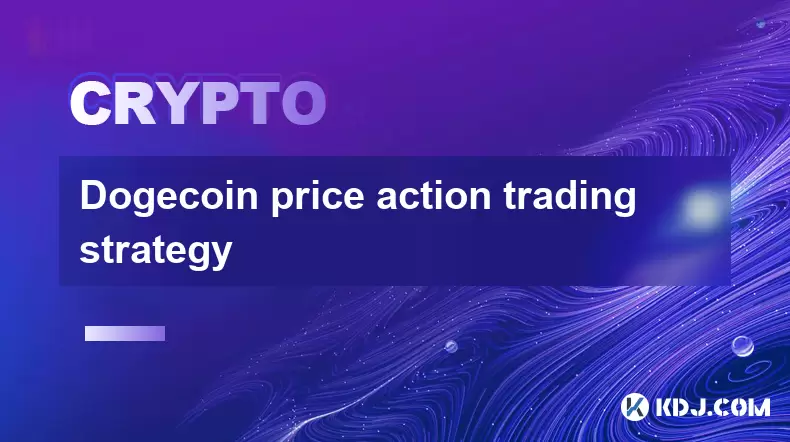-
 bitcoin
bitcoin $116081.691955 USD
0.27% -
 ethereum
ethereum $4718.826985 USD
4.26% -
 xrp
xrp $3.117247 USD
1.97% -
 tether
tether $1.000569 USD
0.05% -
 solana
solana $243.054176 USD
4.43% -
 bnb
bnb $928.830975 USD
2.58% -
 usd-coin
usd-coin $0.999771 USD
0.06% -
 dogecoin
dogecoin $0.279957 USD
6.58% -
 cardano
cardano $0.934111 USD
3.21% -
 tron
tron $0.352358 USD
0.96% -
 hyperliquid
hyperliquid $55.389469 USD
-2.38% -
 chainlink
chainlink $25.141431 USD
2.36% -
 sui
sui $3.750736 USD
1.93% -
 ethena-usde
ethena-usde $1.001249 USD
0.04% -
 stellar
stellar $0.406611 USD
2.17%
Dogecoin price action trading strategy
Dogecoin traders use price action strategies by analyzing candlestick patterns, support/resistance levels, and volume to identify high-probability trade setups and manage risk effectively.
Jul 06, 2025 at 02:21 am

Understanding Dogecoin Price Action Trading Strategy
Dogecoin price action trading strategy revolves around analyzing the movement of Dogecoin (DOGE) prices on charts without relying heavily on traditional indicators. Traders who use this method focus on candlestick patterns, support and resistance levels, volume changes, and overall market sentiment to make informed decisions.
One of the key components of this strategy is identifying reversal points where the price might change direction. These are often found through pin bars, engulfing candles, or inside bars that signal a shift in momentum. Understanding these formations helps traders anticipate potential breakouts or pullbacks.
Another critical aspect involves recognizing trendlines and channels. By drawing accurate trendlines, traders can spot areas where the price may bounce or break through. These zones become crucial for setting entry and exit points in real-time trading scenarios.
Setting Up Your Chart for Dogecoin Price Analysis
To begin implementing a price action trading strategy for Dogecoin, it’s essential to set up your chart correctly. Start by selecting a clean candlestick chart with no unnecessary overlays. Choose a timeframe that suits your trading style—1-hour, 4-hour, or daily charts are commonly used for intraday and swing trading.
Ensure that you have volume indicators enabled, as they help confirm the strength behind price movements. Volume surges during breakouts or reversals can serve as powerful confirmation tools. Also, mark significant support and resistance levels based on historical price data to identify potential trade setups.
Use horizontal lines to highlight key psychological levels such as $0.05, $0.10, or $0.20, which have acted as support or resistance in the past. These levels often influence trader behavior and can lead to repeated price reactions.
Identifying High-Probability Trade Setups
A high-probability trade setup typically forms when price consolidates near a key level and shows signs of rejection. For instance, if DOGE approaches a known resistance level and forms a bearish pin bar, it could indicate selling pressure and a possible reversal.
Conversely, when the price tests a strong support zone and forms a bullish engulfing pattern, it suggests buying interest may take over. Traders should look for confluence between candlestick signals, volume spikes, and nearby support/resistance to increase the odds of success.
It's also important to monitor news events or social media trends related to Dogecoin, as sudden hype or negative sentiment can drastically impact short-term price action. Tools like Twitter sentiment analysis or crypto news aggregators can provide context before entering trades.
Entry and Exit Points Using Price Action Signals
When executing a trade based on price action, precision in entry placement is vital. If a bullish pin bar forms at a support level, traders often enter just above the high of the candlestick to confirm the reversal. Similarly, a bearish engulfing pattern at resistance may prompt a sell order placed just below the low of the formation.
Stop-loss orders should be placed beyond recent swing highs or lows depending on the trade direction. This protects against false breakouts and limits losses. Traders often trail their stop-loss as the trade progresses to lock in profits while allowing room for natural price fluctuations.
Profit-taking can be done in stages—partially closing positions at initial targets and letting the rest ride toward higher resistance zones. This approach balances risk and reward effectively without prematurely exiting potentially profitable trades.
Managing Risk in Dogecoin Price Action Trading
Risk management is a cornerstone of any successful trading strategy, especially in volatile markets like Dogecoin. A common rule followed by experienced traders is to risk no more than 1-2% of total capital per trade. This ensures long-term survival even during losing streaks.
Position sizing must be adjusted according to the distance between entry and stop-loss levels. Wider stop-losses require smaller position sizes to maintain consistent risk exposure. Always calculate your risk-to-reward ratio before entering a trade; aiming for at least 1:2 or higher is ideal.
Diversification across multiple cryptocurrencies can reduce portfolio volatility. However, when focusing solely on Dogecoin, ensure you're not overexposed. Consider hedging strategies or using inverse tokens to protect against sharp downturns in specific market conditions.
Frequently Asked Questions (FAQ)
- What timeframes work best for Dogecoin price action trading?Dogecoin price action works well on 1-hour, 4-hour, and daily charts. Shorter timeframes offer more frequent setups but come with increased noise, while longer timeframes provide clearer trend signals.
How do I know if a price action signal is valid?A valid signal is confirmed when volume aligns with the candlestick pattern, and the price reacts strongly at a previously tested support or resistance level. Avoid trading isolated signals without confluence.
Can I use indicators alongside price action for Dogecoin?Yes, many traders combine volume indicators or moving averages with price action to filter out false signals. However, the core decision-making should remain rooted in pure price action principles.
Is Dogecoin suitable for day trading using price action?Dogecoin is highly volatile and liquid, making it ideal for day trading if proper strategies and risk controls are in place. Always backtest your approach before live trading. Disclaimer:info@kdj.com
The information provided is not trading advice. kdj.com does not assume any responsibility for any investments made based on the information provided in this article. Cryptocurrencies are highly volatile and it is highly recommended that you invest with caution after thorough research!
If you believe that the content used on this website infringes your copyright, please contact us immediately (info@kdj.com) and we will delete it promptly.
- MUTM Token Surge: Is Mutuum Finance the 2025 Gainer?
- 2025-09-13 18:25:13
- WorldShards, SHARDS Token, and Bybit: A Web3 Gaming Revolution?
- 2025-09-13 18:25:13
- AI Coins, Cardano, and Market Cap: What's the Deal?
- 2025-09-13 18:30:12
- Dogecoin Rally Incoming? Why Now Might Be the Time to Buy
- 2025-09-13 18:30:12
- PUMP Price Rockets After Binance Listing & Token Buybacks: What's Next?
- 2025-09-13 18:35:16
- Brett's Surge: Analysts Eye Meme Coin's Next Big Move
- 2025-09-13 18:35:16
Related knowledge

Bitcoincoin burning mechanism
Jul 20,2025 at 09:21pm
What is the Dogecoin burning mechanism?The Dogecoin burning mechanism refers to the process of permanently removing DOGE tokens from circulation by se...

How to earn free Bitcoincoin?
Jul 19,2025 at 10:08pm
What is Dogecoin and Why Earn It?Dogecoin (DOGE) started as a meme-based cryptocurrency in 2013 but has grown into a widely recognized digital asset. ...

Is Coinbase a good wallet for Bitcoincoin?
Jul 19,2025 at 04:42pm
Understanding Coinbase as a Wallet Option for DogecoinWhen considering where to store Dogecoin, Coinbase is often mentioned as a potential option due ...

How to buy Bitcoincoin with PayPal?
Jul 23,2025 at 06:57am
Understanding the Basics of Buying DogecoinBefore diving into the process of buying Dogecoin with PayPal, it’s essential to understand what Dogecoin i...

Best app to buy Dogecoin
Jul 23,2025 at 03:08pm
What Is a Cryptocurrency Exchange and How Does It Work?A cryptocurrency exchange is a digital marketplace where users can buy, sell, or trade cryptocu...

How are Dogecoin gains taxed?
Jul 25,2025 at 07:01am
Understanding the Taxation of Dogecoin GainsWhen it comes to Dogecoin (DOGE), many investors are drawn to its meme-inspired branding and volatile pric...

Bitcoincoin burning mechanism
Jul 20,2025 at 09:21pm
What is the Dogecoin burning mechanism?The Dogecoin burning mechanism refers to the process of permanently removing DOGE tokens from circulation by se...

How to earn free Bitcoincoin?
Jul 19,2025 at 10:08pm
What is Dogecoin and Why Earn It?Dogecoin (DOGE) started as a meme-based cryptocurrency in 2013 but has grown into a widely recognized digital asset. ...

Is Coinbase a good wallet for Bitcoincoin?
Jul 19,2025 at 04:42pm
Understanding Coinbase as a Wallet Option for DogecoinWhen considering where to store Dogecoin, Coinbase is often mentioned as a potential option due ...

How to buy Bitcoincoin with PayPal?
Jul 23,2025 at 06:57am
Understanding the Basics of Buying DogecoinBefore diving into the process of buying Dogecoin with PayPal, it’s essential to understand what Dogecoin i...

Best app to buy Dogecoin
Jul 23,2025 at 03:08pm
What Is a Cryptocurrency Exchange and How Does It Work?A cryptocurrency exchange is a digital marketplace where users can buy, sell, or trade cryptocu...

How are Dogecoin gains taxed?
Jul 25,2025 at 07:01am
Understanding the Taxation of Dogecoin GainsWhen it comes to Dogecoin (DOGE), many investors are drawn to its meme-inspired branding and volatile pric...
See all articles










































































